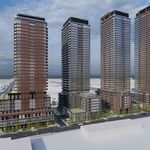It's important to not overly associate Skytrain/ICTS with LIMs though, a feature which at best distracts from the system's successes in other regards. The basic goals and idea which lead to ICTS (the need for a lower cost, lower capacity rapid transit system) are obviously still influential.
This post is strictly about getting my definitions straight as I'm confused as to what people actually mean at this point.
LIM is the only somewhat unique feature to Bombardier's Skytrain that I can see; everything else (signalling, automation, etc.) is very wide spread and mostly predates the 1983 SRT installation.
In fact, I think GO is installing the Alcatel signalling kit into the Union Station corridor but operating in fixed-block mode. Sales enables/disables features as required but the software behind it is the same albeit a newer revision, as the DLR and Vancouver Skytrain and SRT have installed.
So, if not the LIM system what is the outcry about using an ALRT (Alacatel signalling + driver control + Flexity) instead of ALRT (Alacatel signalling + driver control + Skytrain) in the SRT corridor?
It's not pantograph versus 3rd rail. Many small capacity metro systems used as examples above of ALRT use pantographs including some in Madrid.
DLR started with street-safe LRT vehicles not unlike Calgary's trains, so it's not a 'street safe' versus 'not street safe' thing.
What else is there other than LIM versus more traditional traction?
Also, how do the Eglinton tunnel section not qualify as ALRT? No, it's not as cheap as it could be, but it seems to hit the checklist of ALRT features (Automated driver control, moving-block signalling, relatively short trains/smaller stations, etc).
Shrinking the underground stations on Eglinton basically requires changes to building/fire code. Above ground stations are about as small as possible. It's not even rolling stock related. Likewise, elevated or not has zero to do with rolling stock.
I guess I'm just really confused as to what people want versus the defintions they are using.




